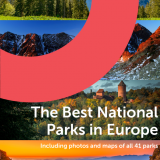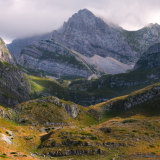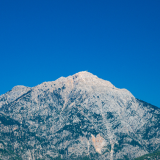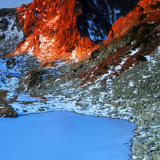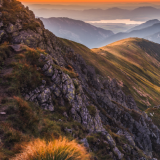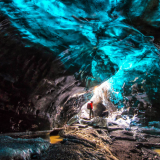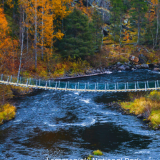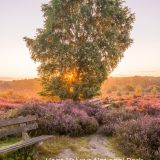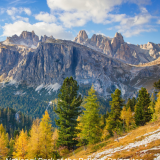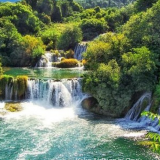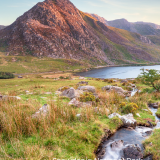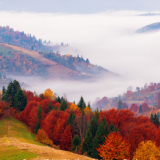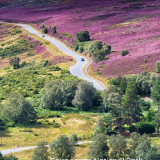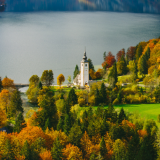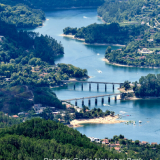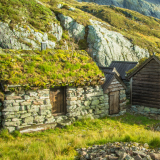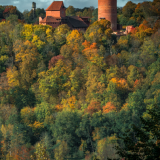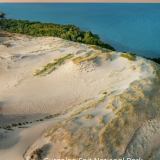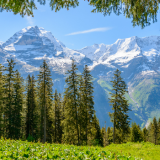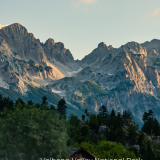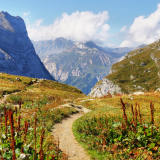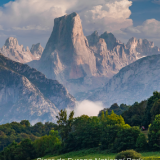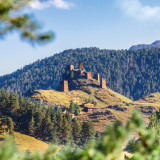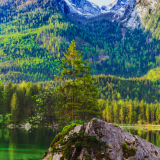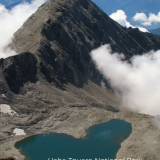Europe stretches from the wild waves of Portugal to the mossy woodlands of Belarus, the tundra of the Scandinavian north to the glistening beaches and down in Greece. Between its borders, this land holds treasures of such immeasurable natural magnificence that it would be a crime to even attempt to distill the lot into a listicle. So, we won’t try. We’ll just offer a taster. AKA: one bucket list-worthy national park for each country that has them.
Valbona Valley National Park, Albania

You can tell that the area of the Valbona Valley is simply sublime. There are regional nature parks and reserves all around it, not to mention a whole other national park across the border in Montenegro to the north. What you get is a bout of the Albanian Alps at their most spectacular, with limestone peaks that form a phalanx on the horizon, dazzling lakes sparkling between wildflower meadows, and chamois hopping the babbling mountain streams.
Hohe Tauern National Park, Austria

Just when you thought the Tyrol couldn’t get any better, it stops serving the piste-side schnitzels and schnapps and offers up the simply wonderful Hohe Tauern National Park. The largest protected reserve in the whole of the Alps proper, the landscape is dominated by the hefty Grossglockner–3,798 meters up and Austria’s highest peak. There’s more hiking than you can yodel at, of course, but also super-famous scenic drives on the Grossglockner High Alpine Road (watch out for the whizzing bikers!) and a heart-shaped lake (one of our favorite heart-shaped travel destinations in the world).
Belovezhskaya Pushcha National Park, Belarus

Covering a moss-caked, rain-dripping forest that’s shared with Poland on the far western edge of Belarus, the Belovezhskaya Pushcha National Park is primarily known as one of the last remaining habitats of the great European bison. But flora fans might prefer the series of ancient oak trees (many of which even have names) and beautiful springtime meadows that bloom with flowers every April and May.
Hoge Kempen National Park, Belgium

Wedged between the town of Genk and the winding Meuse River on the German border, the Hoge Kempen National Park is a pretty patchwork of lakes, heathlands, swamps, and forests. It encircles an ancient area of scree deposits made by various Northern European watersheds, and supports a strange array of creatures–we’re talking the natterjack toad and the Glanville fritillary butterfly, just in case you were wondering.
Kozara National Park, Bosnia and Herzegovina

The Kozara National Park was designated in the erstwhile Yugoslavia by Josip Broz Tito back in 1967. Okay, so that’s hardly John Muir. But hey, there’s no denying the loveliness of the soft mountainsides and their pine woods, the grassy valleys, and the occasional outcrop of rock that defines the vistas. Interestingly, Kozara is also considered an ‘aerial spa’ by the locals: an area that is supposed to help regenerate red blood cells faster on account of its clean air.
Pirin National Park, Bulgaria

Pirin National Park is Bulgaria’s mountain jewel. By summer, it’s a lush land of grass-green slopes and Bulgarian fir woods. By winter, it’s a snow-mantled massif of hulking granite peaks. The summit of Vihren commands the horizon at 2,914 metres, hosting some challenging hiking and scrambling routes. Around that are where the slopes of arguably the Balkans’ most accomplished ski resorts make their home, fanning around the cottages and chalets of little Bansko.
Krka National Park, Croatia

Straddling the Krka River as it weaves and winds its way through the pines and hornbeams from the body-packed Dalmatian Riviera, the Krka National Park is one for the water lovers. The piece de resistance is the Skradinski Buk area, which hosts a whopping 17 waterfalls. They gush across small bluffs into lavender-fringed pools that are crystal clear. Other visitors will head for the Roški Slap part of the park, which has green river ways and hardy hiking paths cut into the cliffs.
Krkonoše National Park, Czech Republic

In Czechia, head north for mountains. That’s where the summits of Sněžka (translating to Snow Mountain) and Skalny Stół arch their backbones across the Polish border. The highest range in the country, the peaks of Krkonoše National Park soar to 1,602 meters above sea level. Around them spans a region that’s ribbed with dangling ski lifts and peppered with pine forests and little spa towns. It’s a darn lovely place to escape to both summer and winter.
Thy National Park, Denmark

Brace yourself for the icy north winds and the full brunt of the North Sea in this wild corner of Denmark. Dashing along the edge of the Jutland peninsula, Thy National Park a barren land of undulating dunes and tumbling sand mounds topped by sea oats. Evidence of human activity here has been traced back all the way to the Viking era, but there’s also something more modern at the WWII exhibits in the Hanstholm Fortress.
Lake District National Park, England

There’s arguably no more English part of England than the Lake District. This is the land of the Romantic Poets of Wordsworth and Blake, of Beatrix Potter, and the ancient stone circles of Castlerigg. These days, it’s a favourite honeymooner’s and rambler’s getaway, fusing hearty waterside cottages with fantastic hikes up barren mountains like Helvellyn Ridge. Also, don’t miss a visit to the traditional pubs of Hawkshead or the charming village of Grasmere.
Lahemaa National Park, Estonia

A quick scoot along the E20 highway from Tallinn and you can be wandering the piney woods and swamps of the Lahemaa National Park. Loads of the capital’s dwellers do that when the Baltic sun gets balmy between May and August, mainly for the long stretches of pebbly beachfront and open-swimming bogs–yep, you can swim in the occasional bog here! Look out for the charming Altja fishing huts and the handsome 1500s mansion at Palmse.
Lemmenjoki National Park, Finland

Lemmenjoki beckons those who want a taste of authentic, distant Finland. Poking into the Arctic Circle on the edge of the territory of the Sami reindeer herders, it’s got wooded fells and wide rivers. Wilderness huts dot the vast 1,100 square miles, offering remote spots for hikers to bed down in complete solitude. Just remember that summertime is always light. Wintertime, on the other hand, brings mainly darkness and potential sightings of the Aurora Borealis.
Vanoise National Park, France

With Tignes, the Tarentaise, and the Three Valleys (the largest interlinked ski field on the globe) on the roster, it’s fair to say that winter sports are usually numero uno for visitors to this corner of the French Alps. But that’s not all there is in Vanoise National Park. The stunning heights of the Savoie range up to the Grande Casse massif and to smaller peaks all around, offering awesome hiking in summer and spring, along with sightings of marmots and lynxes and mountain villages where raclette and smelly cheese is the name of the game.
Tusheti National Park, Georgia

Tusheti National Park protects landscapes that have come to be known by trekkers all over the globe as quintessential Georgia: steep grassy slopes, rocky riverbeds, and lots of snow overhead. Deep in the Greater Caucasus in the far north of the country, there’s some seriously stunning scenery on the menu here. You might have to brave hair-pinning, hair-raising roads to get there, but the medieval towers of Keselo and the cloud-shrouded Abano Pass are just two of the many rewards.
Berchtesgaden National Park, Germany

Just a mention of the Bavarian Alps is usually enough to conjure images of mountaintop yodellers and lederhosen-clad beer drinkers. The reality is probably just a tad different. At Berchtesgaden National Park, you’re more likely to be wowed by the Watzmann peak than by a hops-quaffing local in leather pantaloons. Other highlights include the glimmering Königssee lake and the enthralling Eagle’s Nest–the onetime alpine retreat of Adolf Hitler.
Zakynthos National Marine Park, Greece

This Southern European gem might have the mystical highlands of Mount Olympus up its sleeve on the national parks front, but there’s nothing that says Greece quite like azure bays and swimming sea turtles. Welcome to the 135 square kilometres of the Zakynthos Marine Park, which spreads through fish-teeming Laganas Bay around the coast of the popular holiday island of Zante. Scuba, snorkelling, glass-bottomed boat tours, and yacht destinations–it’s all here!
Aggtelek National Park, Hungary

Get ready to delve underground at the Aggtelek National Park. In a region of high karsts and deep tunnels, this is home to some of the most amazing subterranean systems in the world. There are a whopping 280 caves in the reserve, all carved out of the soft limestone over thousands of years. One of the most amazing is surely the Baradla Cave. It’s doable in a day trip from Budapest (if you can pull yourself away from the baths there) and has colossal stalactites and speleothems of all shapes and sizes.
Vatnajökull National Park, Iceland

Few countries on the globe can boast such raw and rugged nature as Iceland. One fine example of what’s on offer in the Land of Fire and Ice comes in the form of the Vatnajökull National Park. It starts on the coast, where a glassy lagoon is topped by mighty icebergs. Further inland, you can venture to the cascades of Svartifoss falls, which roll over chiselled lava columns. Beyond that are creaking glaciers and geothermal geysers that spurt from the slopes of the Kverkfjöll Mountains.
Wicklow Mountains National Park, Ireland

Seek out the faeries and the folklore of the Emerald Isle by moving south from Dublin’s foot-stomping taverns to the wild Wicklow Mountains. It’s a land that’s long inspired Ireland’s legends and myths, where plains of gryke-laden stone and schist rise to barren peaks and drop to cold lake waters. The idyllic country valley of Glendalough is one of the main highlights, thanks largely to the historic pilgrim’s route of St. Kevin’s Way.
National Park of the Belluno Dolomites, Italy

Italy’s part of the Alps ranges all the way from the French border in the west to the Slovenian lakes in the east. However, there’s perhaps no more striking a part of the region than the Dolomites. They hit a certain zenith near the romantic town of Belluno, where the massifs of the Alpi Feltrine and the twisted tops of the Pizzocco rise high. Below those snowy summits are rolling alpine meadows, turquoise rivers, and pockets of scented pine trees, not to mention fantastic rifugio that serve hearty Italian mountain food and local wines. Hands down one of the best things to do in Italy.
Bjeshkët e Nemuna National Park, Kosovo

Kosovo is proof that size doesn’t matter. The whole country has just 10,000 square kilometres of land. However, there’s enough natural beauty to squeeze in two whole national parks. Of those, it’s the Bjeshkët e Nemuna National Park that’s probably worth a special mention. It butts up to the aforementioned Valbona Valley of Albania in a showcasing of rough grey peaks and Balkan forests. Hiking to rustic villages and lakes is the main activity; just keep watch for lynx, deer, and birds of prey as you walk.
Gauja National Park, Latvia

The Gauja National Park is a real Baltic painter’s palette. Color-changing woodlands of oak and beech all mingle and mix below sandstone hills. There are caves, crop fields around the rural villages, and even a half-ruined medieval castle at Cesis (some say the best-preserved in all of Latvia). The Gauja River anchors the whole place, offering a gorgeous place to hop in the kayak or canoe.
Curonian Spit National Park, Lithuania

Less than one mile wide but more than 60 miles long, the Curonian Spit National Park protects a scythe of dunes and forests and beaches that run along the edge of the Baltic Sea between Lithuania and the Russian exclave of Kaliningrad. Hard to get to but certainly worth the effort, particularly in the summer. It’s known for its huge sand hills and breezy beaches. The access point is the resort of Klaipeda, where you’ll also be able to drop in on a fantastic fortress built by the Teutonic Knights back in the 1200s AD!
Durmitor National Park, Montenegro

The Durmitor National Park has been a designated reserve ever since 1952. It’s now a UNESCO site to boot. And why not? Those shark-fin mountaintops and those high-alpine grasslands that swirl around the soaring summit of Bobotov Kuk are like the picture-perfect intro to the Dinaric Alps. The duo of canyons here is also not to be missed. There’s the Piva River Canyon to the west–home to one eye-watering scenic driving route. And there’s the Tara River Canyon further north–boasting an awesome arch bridge.
Hoge Veluwe National Park, Netherlands

Spreading over a large moraine that was forged during the last ice age, Hoge Veluwe melds heaths and sandbanks and little pockets of pine forest. There are times when it can look more North African than Netherlands, but then you happen upon something like the Kröller-Müller Museum that hosts Dutch masterworks by the likes of Vincent van Gogh. Back in the hinterland, you can enjoy wildlife viewing all year, including foxes, roe deer, and more.
Mavrovo National Park, North Macedonia

Look one way and you’ll see an ancient Orthodox monastery with frescoed domes and arched gatehouses. Look another and the Šar Mountains range into the hazy distance. Then gaze again to see the sprawling waters of Lake Mavrovo, a haven for swimmers and boaters come summer. The largest of the trio of reserves that exists in North Macedonia, Mavrovo National Park offers adventures amid highlands and woodlands not too far from the capital at Skopje.
Folgefonna National Park, Norway

Nope, you’re not in Patagonia. That’s Norway, the sheer majestic side of Norway. Welcome to Vestland and the Folgefonna National Park, a region divvied up into glimmering ice fields and deep valleys that eventually tumble into the rugged fjords of the North Sea. Most come to get up close to a bona fide glacier. You can do that by boat on jaw-dropping Lake Bondhus, or trek higher to the viewing points at Buarbreen.
Tatra National Park, Poland

Poland’s mountains might all be pushed into its southern corner, but they do offer something truly special. Make for the Winter Capital of Zakopane to be immersed in the spires of rock that are the Tatras. An offshoot of the Carpathian Mountains, they come with wonderful trekking opportunities like the hardcore route to the top of Rysy (Poland’s tallest peak) and the scenic walks amid the Valley of the Five Lakes.
Peneda-Gerês National Park, Portugal

If you can tear yourself away from the cellar doors and winding riverbanks of the gorgeous Douro Valley, the Peneda-Gerês National Park beckons with even more country vistas to the north. It butts up to the Spanish border with its bulky sierras that hit heights of more than 1,500 meters above sea level. Waterfalls and age-old granaries are among the top draws, but go deeper for wild swimming at the Cascata da Portela do Homem (the water has a come-dive-in-me bluish tint).
Retezat National Park, Romania

Looking positively alpine, but out on the eastern bends of the Carpathian range, the craggy Retezat Mountains come with countless summits that crash more than 2,300 meters up. They’re at their most eye-catching at the lovely preserves of the Retezat National Park, which is haloed in one of the oldest swathes of virgin forest in Europe. Above lie plateaus and lakes shrouded by the scree ridges of Peleaga (the tallest summit), a land roamed by lynxes and wolf packs.
Losiny Ostrov National Park, Russia

When the suburban sprawl and old Soviet blocks of outer Moscow finally drop away, visitors drift into the wetlands and wilds of Losiny Ostrov. It’s a picture of rural Northern Russia: the sort of landscapes idolized by Tolstoy and Pushkin. The most handsome precincts of the preserve are around the Upper Yauza Swamps, which have stalking moose and pockets of gold-leafed beech trees sprouting from the backwaters.
Kopaonik National Park, Serbia

The highest points in Serbia exist at the Kopaonik National Park, which lifts over 2,000 meters to the country’s most celebrated ski runs and alpine terrain. When there’s no snow for whizzing downhill on two planks, this place is heaven for hikers. They come to navigate the wildflowers and the fir forests, and to enjoy the relatively balmy microclimate that’s said to bless the so-called ‘Sunny Mountain’.
Cairngorms National Park, Scotland

In a country so replete with natural wonders that make you want to yell ‘och, aye!’, the Cairngorms remain a true standout. They occupy a huge cut-out of the Highlands, counting a whopping 1,748 square miles of sculpted mountain terrain. There’s a muscle-spraining 55 Munros (mountains above 3,000 feet) to get through for ramblers, not to mention one of the UK’s few ski resorts at Glenshee. The town of Aviemore is for access and it’s got all the boot shops and hearty Scottish pubs you could want.
Low Tatras National Park, Slovakia

Rolling between Ružomberok and Poprad just south of the Polish-Slovak border in a punk’s belt of spiky peaks, the Low Tatras National Park beckons with all sorts of activities. In the winter, you can venture to arguably the finest ski resorts in Europe outside of the Alps (check out Jasna Chopok). In the summertime, there’s pretty gnarly hiking on the knife-edge ridges that link up Ďumbier and Kralova Hola. Hearty highlander taverns await with dumplings and frothy beers once you’re done.
Triglav National Park, Slovenia

Slovenia’s become something of an Instagram star in recent years and it’s easy to see why. Its hitherto undiscovered backcountry is just about tailor-made for photographers after that pic to stop the thumb a-scrolling. There’s probably nowhere better for that than the eye-wateringly-wonderful Triglav National Park. Set around the Shangri-La of Lake Bohinj, it has emerald waters next to just-as-emerald pine woods and soaring mountains that glimmer like razors beneath cloudless skies.
Picos de Europa National Park, Spain

Spain has loads of national reserves that could easily slide onto this list: the great Teide volcano of the Canaries and the dust-swirling cowboy lands of the Sierra Nevada (yep, Spain had em’ first!). But we think Picos de Europa steals the show. They aren’t that well known, but boy should they be! You’re talking twisted and gnarled spires of limestone that look more like something from Argentina than the land of flamenco and sangria. Wowza!
Abisko National Park, Sweden

There’s only a single road leading in and out of the Abisko National Park. Cut-off and remote in the northern reaches of the Scandinavian Peninsula, it occupies a region known as Swedish Lapland. And if that’s suddenly conjuring visions of snow-doused tundra, husky-pulled sleds, skies that sparkle with the Northern Lights, and herds of reindeer, then you’re on the right track!
Swiss National Park, Switzerland

Swiss National Park dates all the way back to 1914, which makes it one of the oldest government-backed nature reserves on the continent. You can see why they put their finger on it straight away, what with those stunning jagged peaks that run along the border with the Italian South Tyrol, and the turquoise rivers that flow straight down from glacier fields. Covering the Western Rhaetian Alps, it’s actually one of the country’s remoter corners, with peaks like the Piz Pisoc and Quattervals topping the bill.
Beydağları Coastal National Park, Turkey

Okay, so Turkey usually flaunts national parks like the Göreme fairy chimneys and cave cities. However, that’s not strictly in Europe. For European Turkey, you need to hit the Mediterranean coast, which is where you can discover the mountain-backed shores of the Beydağları Coastal National Park. Ancient history runs deep here, with Lycian towns like Olympos and Idyros on the menu. There are also fantastic beaches and pebble coves, of course, so bring the snorkels just in case.
Carpathian National Nature Park, Ukraine

Sub-alpine lands roll through from the Polish Beskids to the Ukrainian Beskids and lift skywards to create this national park right on the roof of the country. The summits are a modest 2,000 meters, but they are swirled with spruce forests and tussock meadows and photogenic waterfalls aplenty. There’s a total of 48 marked trekking routes that are well used, along with traditional timber mountain huts for shelter.
Snowdonia National Park, Wales

Last, but certainly not least, comes the mythic land of Snowdonia, which has been exalted for its feral landscapes since being established in 1951. Lots will come to hike the eponymous mountain of Snowdon, but the trail can be like Manhattan at rush hour thanks to a tourist train that leads to the top. Much better are the lesser-known ridges of Tryfan and Crib Goch. They offer challenges before you return to hearty Celtic pubs in slate-clad villages like Beddgelert and Blaenau Ffestiniog in the valleys below.
